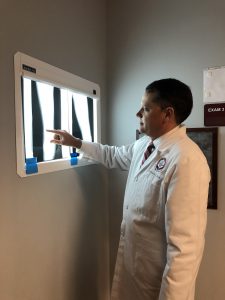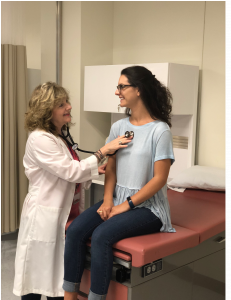PAs on Front Lines Recognize Arthritis Symptoms
Osteoarthritis Action Alliance Helps Share Information
May 2, 2021
By Hillel Kuttler
A decade ago, a woman was brought to McIntosh Clinic, in Thomasville, Ga., in a wheelchair. She suffered from severe joint pain, which prevented her from walking.
The patient was diagnosed with rheumatoid arthritis and treated by medication. Her condition quickly improved, and she went to subsequent appointments on her own two feet.
She was just in her early 40s.
“That’s the thing: We think of arthritis as [striking] folks later in life. But it also happens in the prime of life,” said Benjamin Smith, a PA in McIntosh’s rheumatology outpatient department and director of didactic education at the Florida State University PA Program.
As to how the woman became his patient: Her primary care physician had sent her to the clinic.
“That’s the message: Those on the front lines of patient care can recognize the symptoms and make the referrals,” Smith said.
These and other lessons about rheumatic conditions are being broadly disseminated throughout May, which is Arthritis Awareness Month.
[Daily alerts with relevant clinical news – included with membership]

The Centers for Disease Control and Prevention estimates that 54.4 million adults in the United States suffer from arthritis. The most common forms are osteoarthritis, rheumatoid arthritis, gout, lupus and fibromyalgia.
A key avenue for sharing information on these conditions is the Osteoarthritis (OA) Action Alliance, established by the Arthritis Foundation and the CDC, to bring together a wide range of caregivers, community-based organizations and policymakers.
Kirsten Ambrose, the alliance’s program manager, said that the “whole idea is to mitigate the growing prevalence” of osteoarthritis, which affects 30 million people. Medication treats pain symptoms, but not the condition itself, she noted.
The alliance, composed of 106 organizations, is “in the early stages of engaging with AAPA” on such matters as getting information into the hands of both PAs and OA patients, she said.
Ambrose wants to include a primary-care PA in the alliance’s working group on mobilizing providers to identify issues in treating their arthritic patients, including encouraging them to regularly walk and exercise. The working group includes rheumatologists, pharmacists, physical therapists and other health professionals, she said.
The alliance’s membership and approach cast a wide net in promoting joint health. For example, members include the National Recreation and Park Association, which runs community-based educational programs and physical-activity classes; and the National Athletic Trainers Association, whose neuromuscular training strategies seek to reduce athletes’ knee injuries. One of the alliance’s pamphlets targets youth athletes, because lower-limb injuries, such as tears to the anterior cruciate ligament, “can set the stage for osteoarthritis,” Ambrose explained.
PAs’ participation in the alliance “would be a tremendous win” for the alliance, for AAPA and for arthritic patients, Smith said.

“Meeting the needs of patients is a role we can play. Helping PAs recognize the scope and importance of arthritis of any sort is a valid goal,” Smith said. “It’s always important that PAs have rheumatic disease on their radar when patients present with joint pain. It’s a tremendous opportunity we have as PAs in the treatment of people with arthritis.”
Physical activity and reducing obesity are areas where PAs can best assist patients with arthritis, said Barbara Slusher, a PA serving on the Association of Rheumatology Health Professionals’ Practice Committee (ARHP is a division of the American College of Rheumatology) and an assistant professor in the University of Texas Medical Branch’s Department of PA Studies.
“Exercise probably would be No. 1. Patients are concerned that it could make their arthritis worse, when in fact it’s the opposite. Exercise is critical,” she said, adding that PAs in rheumatology work closely with physical therapists in devising safe workout regimens for their patients.
Obesity “affects those with OA because [it] puts more wear and tear on knees and hips,” Slusher added. “As a patient, that’s something you can control. If you can decrease your weight, you can maintain a higher quality of life for a longer time.”
Those recommendations and others are contained in Stand UP 2 OA, a campaign the alliance launched for Arthritis Awareness Month.
In an article they co-authored in the journal Arthritis Care & Research, Smith and Slusher state that implementing a curriculum outline developed by ACR and ARHP would help in training PAs and NPs to address the workforce shortage in rheumatology.
PAs and NPs “improve access and deliver high-quality rheumatologic care, which may reduce physician clinical and administrative workload, and are well-received by both patients and physicians,” the article states.
An ACR survey conducted in 2005 found that 2,500 rheumatologists would have to be added by 2025 to address the demand for adult rheumatology services, according to another article that Smith co-authored, which appeared in the journal’s April issue.
At least until the practitioners’ gap closes, the message is: Work together and connect the dots.
Said Ambrose: “There’s a tremendous overlap, since half the people with heart disease and diabetes also have arthritis, and a third of those with obesity also have arthritis. Management strategies around them, such as exercise and weight management, are the same for all those conditions. We want to assure that PAs know that these are all interconnected conditions.”
Hillel Kuttler is a freelance writer. Contact him at [email protected].
Editor’s note: This article originally appeared in May 2018.
Thank you for reading AAPA’s News Central
You have 2 articles left this month. Create a free account to read more stories, or become a member for more access to exclusive benefits! Already have an account? Log in.



